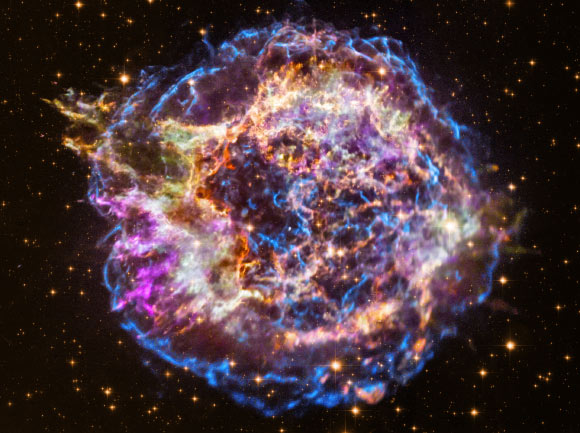Chandra Tracks Evolution of Cassiopeia A Supernova Remnant | Astronomy – Sci-News.com
A new video released by NASA’s Chandra mission shows how Cassiopeia A has evolved over more than a dozen years in X-ray light.
Cassiopeia A, which is located about 11,000 light-years from Earth, is the most studied nearby supernova remnant.
When the original star ran out of fuel, it collapsed onto itself and blew up as a supernova, possibly briefly becoming one of the brightest objects in the sky.
Although astronomers think that this happened around the year 1680, there are no verifiable historical records to confirm this.
The shock waves generated by this blast supercharged the stellar wreckage and its environment, making the debris glow brightly in many types of light, particularly X-rays.
The new video, created by the Chandra team, shows the evolution of Cassiopeia A over time, enabling viewers to watch as incredibly hot gas — about 20 million degrees Fahrenheit (over 11 million degrees Celsius) — in the remnant expands outward.
The blue, outer region of the remnant shows the expanding blast wave of the explosion.
The blast wave is composed of shock waves, similar to the sonic booms generated by a supersonic aircraft.
These expanding shock waves produce X-ray emission and are sites where particles are being accelerated to high energies.
As the blast wave travels outwards at speeds of about 11 million mph (17.7 million kmh), it encounters surrounding material and slows down, generating a second shock wave — called a reverse shock — that travels backwards, similar to how a traffic jam travels backwards from the scene of an accident on a highway.
These reverse shocks are usually observed to be faint and much slower moving than the blast wave.

This composite image of Cassiopeia A combines data from NASA’s Chandra X-ray Observatory color coded by element, ground-based images obtained in 1996 and 1999, and images taken by the NASA/ESA Hubble Space Telescope between 2004 and 2011. Image credit: NASA / CXC / SAO / STScI.
However, RIKEN astronomer Toshiki Sato and colleagues recently reported reverse shocks in Cassiopeia A that appear bright and fast moving, with speeds between about 5 and 9 million mph (8-14.5 million kmh).
These unusual reverse shocks are likely caused by the blast wave encountering clumps of material surrounding the remnant.
This causes the blast wave to slow down more quickly, which re-energizes the reverse shock, making it brighter and faster.
Particles are also accelerated to colossal energies by these inward moving shocks.





